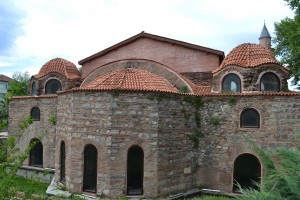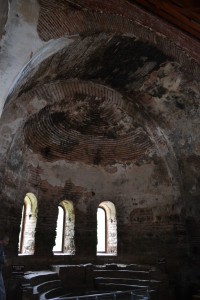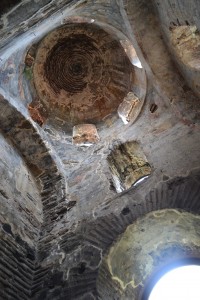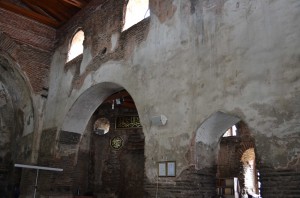Iznik’s Aya Sofya is the centre of town. This was the Patriarchal Church during the occupation of Constantinople and the centre of an Ecumenical Council in 787. This was during the great battle between iconoclasm and orthodoxy. The Seventh Ecumenical Council had been convened by the iconoclast Emperor Constantine V in his palace at Hieria on the Asian side opposite Constantinople in 754. This was a dark period in church history. The Patriarchates of Antioch, Alexandria and Jerusalem were occupied by Islamic rule. Rome, with its support of Christian imagery, was not invited to take part. Anastasios, the Patriarch of Constantinople, whose support for iconoclasm had only been obtained when emperor whipped, blinded and paraded him through the streets in shame, had finally died. Constantine V took the opportunity of institutionalising iconoclasm by calling in a convocation of bishops that he knew he could control.
Unsurprisingly, the inevitable ruling of this Council was not accepted by the mainstream of the church. By 786, the position of Patriarch had regained something of its former power. The new Patriarch, Tarasius, wished to re-establish links with the other churches and a new Council was convened in the Church of the Holy Apostles in Constantinople. The Roman Pope sent representation and it seemed inevitable that iconoclasm would be defeated until military units disrupted the proceedings, demanding a return to the dictates of the emperor.
Some subterfuge in the shape of a hastily contrived campaign appears to have diverted the agitators and the Council was relocated to Nicaea. The Church of the Holy Wisdom (Agia Sophia) was the centre of proceedings. This was built in the 6th century on the orders of Justinian I at around the same time as the Agia Sophia in Constantinople. The shape of the present church may come from an 11th century reconstruction following the inevitable earthquake. It is a basilica with a central nave along an east-west axis and smaller aisles either side. The wide nave ends in an apse with a synthronon, a set of semicircular steps for members of the clergy. There is a single narthex inside the entrance on the western side. The domes atop the eastern ends of the two outer aisles were built in either the 11th or 13th century and were once above chapels separate from the rest of the church. There is some doubt that the existing building named Aya Sofya is the Church of Agia Sophia in which the 7th Ecumenical Council was held. One objection is that it was too small to contain the crowd of more than 300 bishops and their entourages. More can be read about this here.
In any case, it was in Nicaea that a halt to iconoclasm was called. However, the iconoclastic faction remained influential and the Emperor once again outlawed the making and veneration of icons in 815. The Seventh Ecumenical Council (Second Council of Nicaea in 787) is the last of the councils to be recognised by both the Eastern and Western Christian churches. The schism finally became official in the eleventh century.
With the Fourth Crusade rather emphatically ending the reign of Constantinople as the centre of the Orthodox Church, nominal patriarchates sprang up in three splinter states: the Empire of Nicaea, the Empire of Trebizond and the fabulously named Despotate of Epirus. History records Nicaea (Iznik) as having the most legitimate claim as this is where the Byzantine Emperor Theodore Lascaris took refuge and rebuilt his power base. Michael VII Paleologus of Nicaea rebounded and retook Constantinople in 1261, ending the debate about which political entity was the legitimate successor to Constantinople.
When I visited Iznik in 1990, Aya Sofya was a lovely ruin. Now it is a different building, a sort of government mosque placed uncomfortably inside an unsympathetically restored relic. The restoration will ultimately increase the survival potential of the remains. It’s just a bit concrete-and-plastic. (40.429203,29.719938)
The thirteenth century flowering of Nicaea as the home of the exiled Patriarchate led to the construction of a number of churches and the repair of existing ones. However, after Ottoman conquest, the city of Iznik was impoverished and underpopulated. The churches gradually became more and more dilapidated until the Turkish War of Independence. Iznik was in the path of the Turkish Army which, scenting victory, drove the hapless Greek population towards the Aegean coast. Iznik, having a large Christian presence, was a target. All churches were destroyed with the exception of Aya Sofya, which had been converted into a mosque.

Categories: Uncategorized | 1 Comment »





June 30th, 2014 at 12:37 pm
[…] Aya Sofya, Iznik (Nicaea) […]